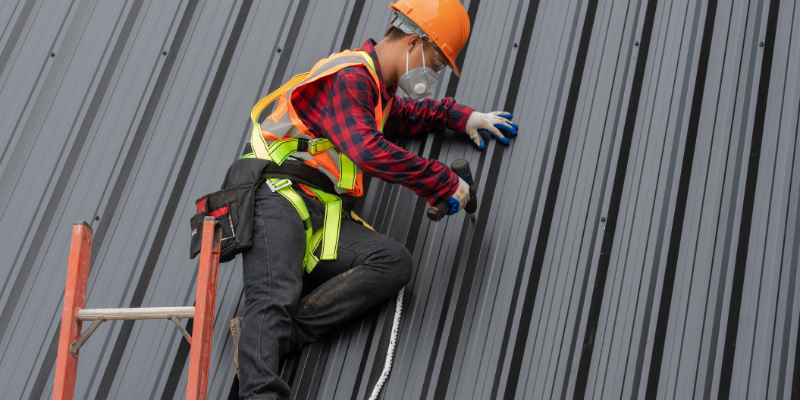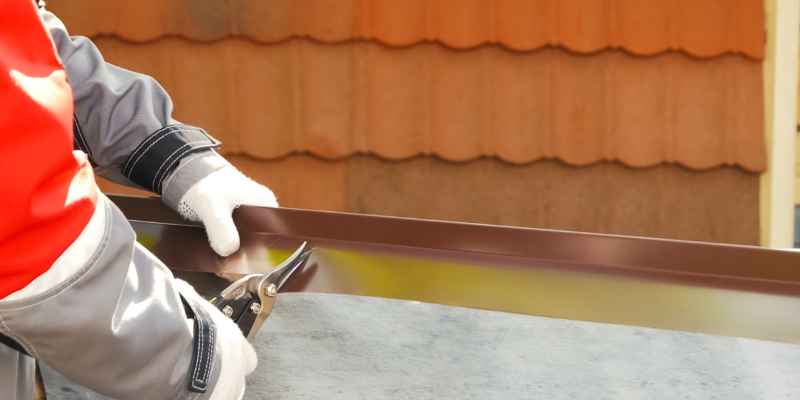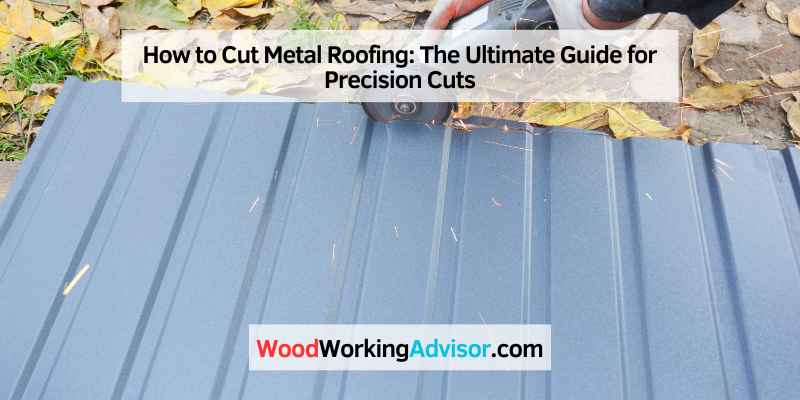To cut metal roofing, you can use power shears or a circular saw with a metal-cutting blade. Here’s how to cut metal roofing effectively.
Are you planning to install a metal roof? Cutting metal roofing sheets to the right size is an essential step in the installation process. Whether you’re replacing damaged panels or customizing the dimensions for a specific project, cutting metal roofing accurately is crucial.
In this guide, we’ll explore two common methods for cutting metal roofing: using power shears and using a circular saw with a metal-cutting blade. By following these steps, you’ll be able to cut metal roofing with ease and precision.
Types Of Metal Roofing
Corrugated Metal
Corrugated metal roofing is known for its durability and cost-effectiveness.
The wavy pattern adds strength to the roof and helps with water runoff.
- Very popular for agricultural, industrial, and residential applications.
- Easy to install and provides good insulation, reducing energy costs.
Standing Seam
Standing seam roofs have vertical panels with raised seams.
This design creates a sleek, modern look and enhances water resistance.
- Commonly used in commercial and upscale residential construction.
- Provides great resistance against leaks and requires minimal maintenance.

Tools For Cutting Metal Roofing
When it comes to cutting metal roofing, having the right tools is essential for a precise and efficient job. Below, we will discuss the various tools commonly used for cutting metal roofing, including the circular saw, electric shears, nibbler, and snips.
Circular Saw
A circular saw is a versatile tool that can be used for a variety of cutting tasks, including cutting metal roofing. With its powerful motor and adjustable blade, a circular saw allows for quick and straight cuts, making it an ideal choice for larger projects.
Using a circular saw to cut metal roofing is relatively straightforward. Start by measuring and marking the desired cut line on the roofing material. Ensure the blade is appropriate for cutting metal, such as a carbide-tipped or abrasive blade. Secure the metal roofing sheet firmly and guide the saw along the marked line, applying steady pressure to achieve clean and precise cuts.
Electric Shears
Electric shears are specifically designed for cutting metal, making them an excellent tool for cutting metal roofing. These shears utilize a set of sharp rotating blades to effortlessly cut through the material, providing clean and accurate results.
When using electric shears, start by marking the desired cut line on the metal roofing sheet. Place the shears at the starting point of the line and ensure a secure grip on the material. Activate the shears and guide them along the marked line, maintaining a steady and controlled motion. Electric shears are particularly useful for curved or intricate cuts.
Nibbler
A nibbler is a specialized tool designed exclusively for cutting through metal. With its unique cutting mechanism, a nibbler is perfect for making precise and intricate cuts in metal roofing.
To use a nibbler, mark the desired cut line on the metal roofing sheet. Secure the sheet and position the nibbler next to the starting point of the line. Apply gentle pressure on the tool, allowing the rotating cutting head to gradually penetrate the metal. Move the nibbler along the marked line, keeping a steady hand for clean and accurate cuts.
Snips
Snips, also known as aviation snips or tin snips, are handheld cutting tools commonly used for cutting metal. These tools are practical, affordable, and suitable for smaller projects or precise cutting tasks.
When using snips for cutting metal roofing, mark the desired cut line on the material. Position the snips at the starting point of the line and apply consistent pressure while squeezing the handles together. For longer cuts, it may be necessary to reposition the snips multiple times. Snips offer excellent maneuverability and can easily cut through the metal with their sharp cutting edges.
Safety Precautions
Metal roofing is a durable and versatile choice for many projects, but it’s essential to prioritize safety when working with this material. By taking the proper precautions, you can ensure a smooth and hazard-free roofing process. Here are the fundamental safety measures to follow when cutting metal roofing.
Protective Gear
Before starting any roofing project, it’s crucial to equip yourself with the right protective gear. This includes wearing heavy-duty gloves to protect your hands from sharp edges and potential cuts. Additionally, safety goggles should be worn to shield your eyes from metal shavings and other debris. Lastly, a dust mask can help prevent inhalation of metal particles and other harmful substances.
Securing The Roofing
Prior to cutting metal roofing, it’s vital to secure it in place to prevent any movement or slippage. For large sheets, use roofing clamps or screws to firmly hold the material in position. This ensures stability and helps reduce the risk of accidents during the cutting process.
Safe Handling Of Tools
When working with tools to cut metal roofing, it’s essential to handle them with care and attention to detail. Ensure that saws and shears are sharp and in optimal condition to facilitate clean and precise cuts. Always maintain a steady grip on the tools, and be mindful of the blade’s positioning to avoid accidental contact with skin or clothing.
Cutting Techniques
When it comes to working with metal roofing, utilizing the right cutting techniques is essential to ensure precise and efficient results. Whether you’re installing a new metal roof or undertaking repairs, understanding how to cut metal roofing properly can make a significant difference in the project’s success. In this section, we’ll explore three cutting techniques that are commonly used for working with metal roofing: using a circular saw, electric shears, and aviation snips.
Using A Circular Saw
A circular saw is a powerful tool that provides a quick and precise method for cutting metal roofing panels. When using a circular saw, it’s crucial to equip it with a metal-cutting blade specifically designed for this purpose. The blade should have carbide-tipped teeth to effortlessly slice through the metal panels without causing any damage to the material. When cutting with a circular saw, it’s important to secure the metal roofing panel firmly in place using clamps to prevent any movement during the cutting process. Additionally, wearing safety goggles and gloves is essential to protect yourself from any metal shards or debris.
Using Electric Shears
Electric shears are an excellent choice for cutting tight curves and intricate patterns on metal roofing panels. These shears provide a smooth and clean cut without producing any metal shavings or burrs. When using electric shears, it’s important to select the appropriate blade type based on the thickness of the metal roofing. Additionally, ensuring that the shears are properly lubricated will help maintain their cutting efficiency and extend their lifespan.
Using Aviation Snips
Aviation snips, also known as tin snips, are versatile hand tools widely used for cutting metal roofing panels. There are three primary types of aviation snips: straight-cut snips, left-cut snips, and right-cut snips, each designed for specific cutting directions. When using aviation snips, it’s important to mark the cutting line on the metal roofing panel accurately before initiating the cut. This ensures precision and accuracy while using the snips. Additionally, maintaining sharp blades on the snips is crucial for achieving clean and smooth cuts.
Tips For Precision Cuts
Learn the best tips for precision cuts when working with metal roofing. Use a quality saw blade designed for metal and ensure it’s securely mounted. Measure and mark the cutting line accurately, then proceed with a steady and controlled cutting motion to achieve clean, accurate cuts every time.
Measuring And Marking
Accurate measurements and markings are essential for achieving precise cuts when working with metal roofing. Before cutting the metal, make sure you have measured the area carefully and marked it accordingly. Use a tape measure to determine the exact dimensions, and mark the cutting line with a permanent marker or a scribe tool. This will act as a guide for your cuts and help ensure that you achieve the desired precision.
Cutting Speed
The speed at which you cut the metal roofing can greatly affect the accuracy of your cuts. While it may be tempting to rush through the process, it is important to maintain a steady and controlled cutting speed. Rapid movements can lead to less precise cuts and increase the chances of errors. Take your time, maintain a consistent pace, and focus on keeping the saw or shears aligned with the marked cutting line. This will help you achieve clean and accurate cuts.
Avoiding Warping
Warping is a common issue that can occur when cutting metal roofing. To prevent warping, it is crucial to use the right tools and techniques. When using power tools such as electric shears or circular saws, be sure to apply equal pressure throughout the cut to avoid creating uneven stress on the metal. Additionally, using a cutting lubricant can help reduce friction, heat, and the risk of warping. Remember to follow the manufacturer’s instructions and wear safety goggles and gloves when using power tools.
To further minimize the risk of warping, it is advisable to work with adequately supported metal roofing sheets. A sturdy workbench or sawhorses can provide the necessary support and stability. By keeping the metal roofing flat and well-supported during the cutting process, you can help ensure straight and accurate cuts.
Common Mistakes To Avoid
Metal roofing can bring many benefits, but cutting it requires precision and care. Avoiding common mistakes is crucial to a successful roofing project.
Not Using Proper Tools
Using the correct tools is essential when cutting metal roofing. Avoid using tools that are not designed for this purpose.
Incorrect Measurements
Accurate measurements are vital to ensure your metal roofing fits properly. Double-check measurements before cutting.
Rushing The Cutting Process
Take your time when cutting metal roofing to avoid mistakes. Rushing can lead to errors that may require costly corrections.
Maintenance And Aftercare
Cutting metal roofing requires careful planning and precision. Follow these expert tips to ensure a successful cut and maintain the roofing’s durability and longevity.
Maintenance and Aftercare are crucial aspects of cutting metal roofing to ensure its longevity and durability. Following the cutting process, it is essential to Clean Metal Shavings to prevent corrosion and maintain the roof’s integrity.
Cleaning Metal Shavings:
To clean metal shavings, use a strong magnet to attract loose particles and dispose of them properly. A soft brush can be used to sweep away any remaining debris without scratching the surface.
Inspecting the Cuts:
Inspect the cuts carefully to ensure they are smooth and precise. Any rough edges or imperfections should be addressed promptly to prevent water infiltration and rust. Check for burrs and sharp edges that can pose safety hazards.
Applying Protective Coating:
After cutting metal roofing, it is recommended to apply a protective coating to prevent rust and corrosion. Choose a high-quality metal roof paint or sealant that is suitable for the specific metal type used in your roofing.
By following these maintenance and aftercare steps, you can prolong the lifespan of your metal roofing and ensure it remains in top condition for years to come.

Frequently Asked Questions Of How To Cut Metal Roofing
How Do You Measure And Mark The Metal Roofing For Cutting?
To measure and mark the metal roofing, use a tape measure to determine the exact dimensions needed. Then, use a marker or chalk to make precise markings on the metal surface before cutting.
What Are The Best Tools For Cutting Metal Roofing?
The best tools for cutting metal roofing include tin snips, electric shears, or a circular saw with a metal-cutting blade. These tools are designed to provide clean and accurate cuts on metal roofing materials.
What Safety Precautions Should Be Taken When Cutting Metal Roofing?
When cutting metal roofing, always wear protective gear such as safety goggles, gloves, and ear protection. Additionally, ensure that the work area is clear of debris and secure the metal roofing panels to prevent accidents.
How Do You Prevent Metal Shavings From Accumulating During Cutting?
To prevent metal shavings from accumulating, use a vacuum equipped with a brush attachment to immediately clean up any debris. It’s important to keep the work area clean to avoid potential safety hazards and maintain a tidy workspace.
Conclusion
Cutting metal roofing requires proper tools and techniques to ensure accurate and safe results. By following the steps outlined in this guide, you can confidently tackle your metal roofing project. Remember to prioritize safety by wearing protective gear and ensuring a stable work environment.
With practice and patience, you’ll become proficient in cutting metal roofing and achieve professional-looking results for your projects.


